Summary: Difference between revisions
Blueapple128 (talk | contribs) |
Blueapple128 (talk | contribs) No edit summary |
||
| Line 403: | Line 403: | ||
** The dark yellow graph represents EVs. The EVs graph is also lower-bounded at approximately 10% (for stats with 0 EVs) and the edge of the graph represents exactly 252 EVs. Once a Pokémon is Fully Trained, the dark yellow color will change to light blue. | ** The dark yellow graph represents EVs. The EVs graph is also lower-bounded at approximately 10% (for stats with 0 EVs) and the edge of the graph represents exactly 252 EVs. Once a Pokémon is Fully Trained, the dark yellow color will change to light blue. | ||
** The light yellow graph represents base stats, IVs and nature,{{fact}} and does not change size or shape as the Pokémon levels up. It does not appear to be scaled to the Pokémon's actual stats, as there is no HP bulge for Pokémon with equal base stats/IVs/EVs and neutral nature. The 10% lower-bound represents a hypothetical base stat of 0 with 0 IVs, while the edge of the graph represents a base stat of 255 with 31 IVs{{fact}} (for example, most {{p|Chansey}} will have their HP barely miss the edge of the graph). Due to the two different scales involved, there is nothing significant about any part of the EV graph exceeding the bounds of the light yellow graph. | ** The light yellow graph represents base stats, IVs and nature,{{fact}} and does not change size or shape as the Pokémon levels up. It does not appear to be scaled to the Pokémon's actual stats, as there is no HP bulge for Pokémon with equal base stats/IVs/EVs and neutral nature. The 10% lower-bound represents a hypothetical base stat of 0 with 0 IVs, while the edge of the graph represents a base stat of 255 with 31 IVs{{fact}} (for example, most {{p|Chansey}} will have their HP barely miss the edge of the graph). Due to the two different scales involved, there is nothing significant about any part of the EV graph exceeding the bounds of the light yellow graph. | ||
*** The above representation of base stats, IVs and nature does not take into account {{p|Shedinja}}'s unique HP override. A Shedinja with a very high HP IV may have the HP part of its graph well over the 10% minimum and very close to some of its other low stats such as Special Attack and Special Defense. | *** The above representation of base stats, IVs and nature does not take into account {{p|Shedinja}}'s unique HP override. A Shedinja with a very high HP IV may have the HP part of its graph well over the 10% minimum and very close to some of its other low stats such as Special Attack and Special Defense. In contrast, a Chansey with a very low Attack/Defense IV may display closer to the 10% minimum than Shedinja's HP. | ||
=====In battle===== | =====In battle===== | ||
Revision as of 21:41, 21 May 2022
The summary (Japanese: つよさをみる check strength), known as stats in Generation I and II games, and as check summary from Pokémon: Let's Go, Pikachu! and Let's Go, Eevee! onwards, contains information about a Pokémon. It is accessed from the party and battle screens, as well as from the Pokémon Storage System.
The summary is divided into multiple screens, for different kinds of information. In Generation I only, the game will always display both stats screens of a Pokémon (in order) before returning to the party screen, and it is not possible to switch directly between the stats screens of different Pokémon. Starting from the Generation II games, it is possible to press up and down to check the previous and next Pokémon, as well as press left or right to choose between different summary screens.
Starting from Generation IV, there is also a different version of the summary screen, with less information, when viewed during a battle.
Available information

|
This section is incomplete. Please feel free to edit this section to add missing information and complete it. Reason: Missing BDSP and LA |
This is the information available in the summary screen in all core series games.
The summary is unaffected by volatile changes in battle. For instance, a species change caused by Transform, a type change caused by Conversion, a move learned from Mimic, or an Ability exchanged with Skill Swap are not shown in the summary screen.
| Game | RBY | GSC | RSE | FRLG | DPPt | HGSS | BW | B2W2 | XY | ORAS | SM | USUM | PE | SwSh |
|---|---|---|---|---|---|---|---|---|---|---|---|---|---|---|
| Nickname, species, type, OT, OT ID, level, experience, experience required to level up, HP (current and maximum), stats, status condition, list of moves and their PP |
✔ | |||||||||||||
| National Pokédex number | ✔ | ✘ | ||||||||||||
| Regional Pokédex number | ✔ | ✘ | ✔ | |||||||||||
| Gender symbol, held item, Pokérus symbol |
✘ | ✔ | ||||||||||||
| Shiny symbol | ✘ | ✔ | ✘ | ✔ | ||||||||||
| Nature, Ability, markings, Poké Ball, meeting area, meeting level; move's type, power, accuracy, and description |
✘ | ✔ | ||||||||||||
| Move's condition, appeal, and Contest or Super Contest description |
✘ | ✔ | ✘ | ✔ | ✘ | ✔ | ✘ | |||||||
| Move's jamming | ✘ | ✔ | ✘ | ✔ | ✘ | |||||||||
| Ribbons, characteristic, and meeting date; move's category |
✘ | ✔ | ||||||||||||
| Condition | ✘ | ✔ | ✘ | ✔ | ✘ | |||||||||
| Sheen; flavor liked | ✘ | ✔ | ✘ | |||||||||||
| Shiny Leaf | ✘ | ✔ | ✘ | |||||||||||
| Dynamax Level | ✘ | ✔ | ||||||||||||
Nickname
A Pokémon with no nickname is known by its species. In addition, there is a separate field specifically for the Pokémon species in all games, therefore the species appears twice for a Pokémon with no nickname.
Pokédex
In Generation II, the only Pokédex number displayed in the summary is from the Old Pokédex (later known as National Pokédex). In other games prior to Generation VII, the regional Pokédex number appears in the summary screen until the player receives the National Pokédex. From that point onward, the National Pokédex number appears instead. However, this has no effect on Pokémon available in the Kanto-based games, because their Kanto Pokédex number matches their National Pokédex number.
Moves
In Generation I and II, the stats screen includes a simple list of moves; only the move's name, current PP and maximum PP are shown.
In Generation II only, there is also a "move" (Japanese: つかえるわざ usable techniques) option accessible from the party, which is larger and more detailed than the list of moves found in the stats screen. The move option displays the moves' type, power, and text description as well (but not their accuracy, unlike later games). The "move" option is unavailable during Pokémon battles (even though the summary screen can still be used in battles).
From Generation III onwards, the list of moves is more detailed. It includes the moves' type, power, accuracy, and text description. From Generation IV onwards, it also displays the move's category (physical, special, or status move).
In the Hoenn and Sinnoh-based games, there are two separate move screens: one displays battle properties of moves as usual, and the other displays their properties when used during Contests or Super Contests, which includes the moves' condition and appeal. Only in the Hoenn-based games, the move's jamming is shown in the summary as well.
Ordering moves
From Generation I to Generation III, the player may change the order of moves by pressing Select at the list of moves during battle.
In Generation II only, the separate "move" option accessed from the party also allows the player to change the order of moves.
From Generation III onwards, the player may use the summary screen to change the order of moves.
Area and level met
In Pokémon Crystal, the area where each Pokémon was met, as well as their level at the time, are internally stored in the game data, but they are not shown in the stats. The Poké Seer, an elderly woman in Cianwood City, can tell when a Pokémon where and when a Pokémon in the Trainer's party has been caught. She will also comment about how much the Pokémon's level has grown from when it was caught.
If a Pokémon is transferred to a Generation I game, this data is permanently lost; however, it is retained when traded to Pokémon Gold and Silver, despite those games not recording this data.
From Generation III onward, this information is found in the Pokémon's summary.
Contest information
In Pokémon Ruby, Sapphire, and Emerald, the condition and sheen of a Pokémon are shown in the PokéNav, not in the summary. In some of the later games, they are shown in the summary.
Ribbons
In Pokémon Ruby, Sapphire, and Emerald, the Ribbons of a Pokémon are shown in the PokéNav, not in the summary. The summary only displays the number of Ribbons of a Pokémon.
In Generation V, if a Pokémon has no Ribbons, then the summary screen about Ribbons is not displayed at all for that Pokémon.
Markings
From Generation III to Pokémon Black and White, a Pokémon's markings are displayed in the summary, but the player may not use the summary to add or remove the markings. The markings may be added or removed in the PokéNav (only in Pokémon Ruby, Sapphire, and Emerald), as well as in the Pokémon Storage System.
From Black 2 and White 2 onwards, the summary may also be used to add or remove a Pokémon's markings, and the Pokémon Storage System may still be used for the same purpose. For comparison, this feature is not available at the PokéNav Plus in Pokémon Omega Ruby and Alpha Sapphire (unlike the PokéNav in Generation III games).
Regional differences
- In the Japanese version of the Generation I games, the Pokémon's level is repeated in the first and second screens. In other language versions, the level is only shown in the first screen.
- In the Japanese and Korean versions of the Generation II games, the stats screen is vertically divided in two parts; in all other languages, it is divided horizontally.
Gallery
Generation I

|
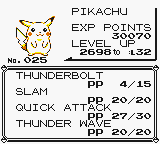
|
|---|---|
| Screen 1 | Screen 2 |
Pokémon Stadium Japanese
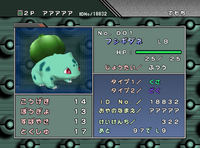
|
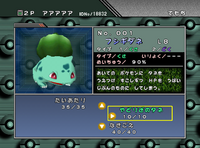
|

|

|
|---|---|---|---|
| Screen 1 | Screen 2 | Screen 1 | Screen 2 |
Pokémon Stadium English
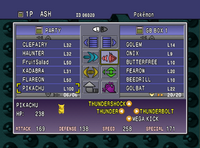
|

|

|
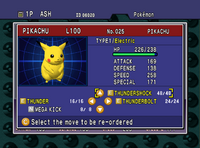
|
|---|---|---|---|
| Screen 1 | Screen 2 | Screen 3 | Screen 4 |
Generation II
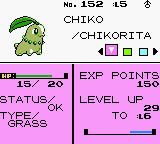
|
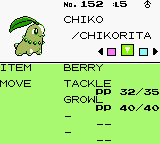
|

|
|---|---|---|
| Screen 1 | Screen 2 | Screen 3 |

|
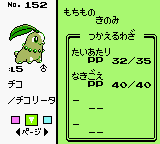
|
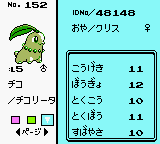
|
| Screen 1 (Japanese) | Screen 2 (Japanese) | Screen 3 (Japanese) |
Pokémon Stadium 2
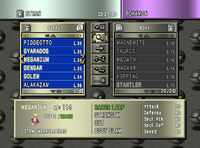
|
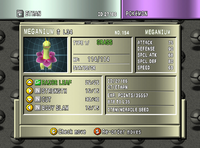
|
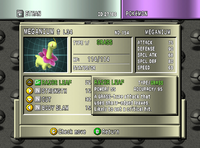
|
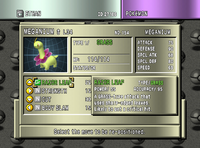
|
|---|---|---|---|
| Screen 1 | Screen 2 | Screen 3 | Screen 4 |
Generation III
Pokémon Ruby and Sapphire
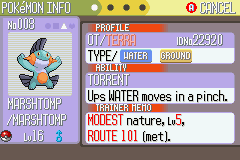
|
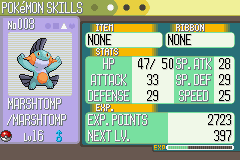
|

|
|---|---|---|
| Pokémon Info | Pokémon Skills | Battle Moves |

|
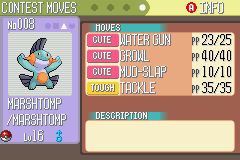
|

|
| Battle Moves (move description) |
Contest Moves | Contest Moves (move description) |
Pokémon Emerald

|

|

|
|---|---|---|
| Pokémon Info | Pokémon Skills | Battle Moves |
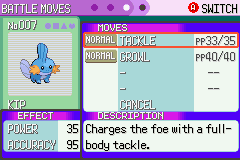
|

|

|
| Battle Moves (description) |
Contest Moves | Contest Moves (description) |
Pokémon FireRed and LeafGreen

|
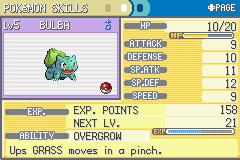
|

|

|
|---|---|---|---|
| Pokémon Info | Pokémon Skills | Known Moves | Known Moves (description) |
Pokémon Colosseum

|

|
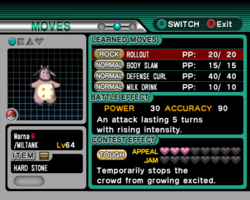
|
|---|---|---|
| Pokémon Info | Moves | Moves (description) |

|
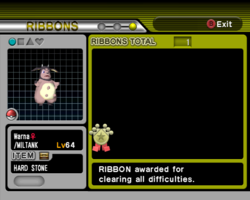
| |
| Ribbons | Ribbons (description) |
Pokémon XD: Gale of Darkness

|
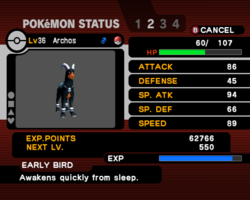
|
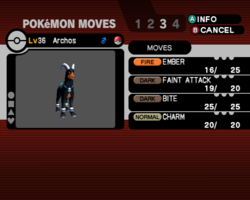
|
|---|---|---|
| Pokémon Info | Pokémon Status | Pokémon Moves |

|

|

|
| Pokémon Moves (description) |
Pokémon Ribbons | Pokémon Ribbons (description) |
Pokémon Box Ruby & Sapphire

|
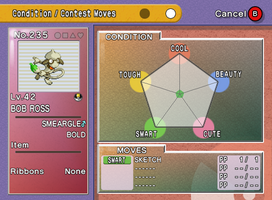
|
|---|---|
| Pokémon Skills / Battle Moves | Condition / Contest Moves |
Generation IV
Pokémon Diamond, Pearl, and Platinum
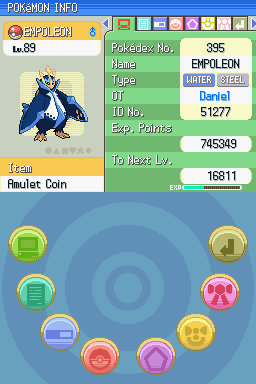
|
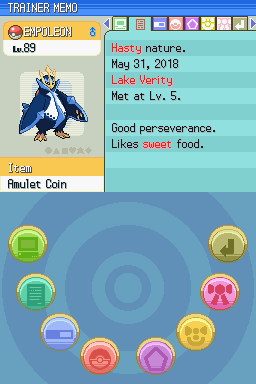
|

|

|
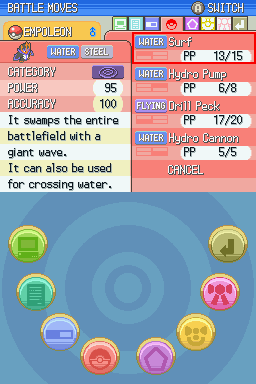
|
|---|---|---|---|---|
| Pokémon Info | Trainer Memo | Pokémon Skills | Battle Moves | Battle Moves (description) |

|
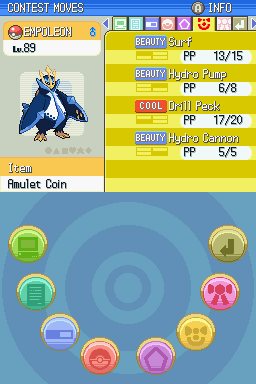
|
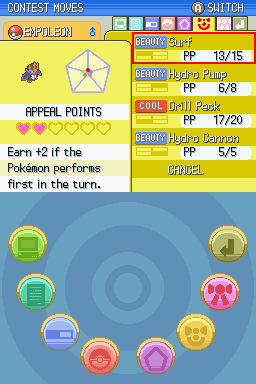
|

|

|
| Condition | Contest Moves | Contest Moves (description) |
Ribbons | Ribbons (description) |
In battle
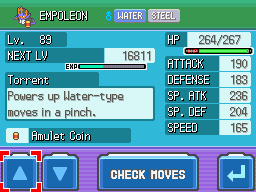
|

|

|
|---|---|---|
| Summary | Check Moves | Check Moves (description) |
Pokémon HeartGold and SoulSilver

|
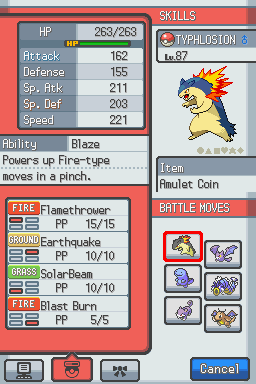
|
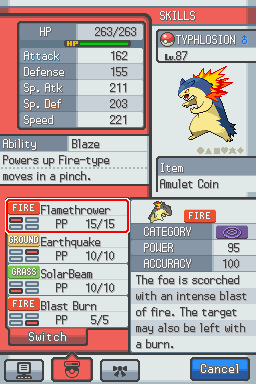
|
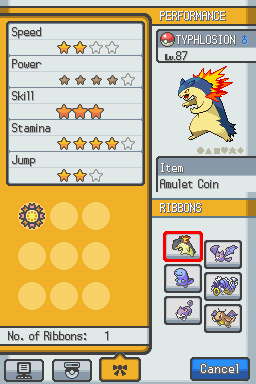
|

|
|---|---|---|---|---|
| Trainer Memo; Info | Skills; Battle moves | Skills; Battle moves (description) |
Performance; Ribbons | Performance; Ribbons (description) |
In battle
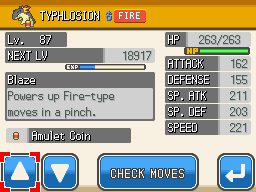
|
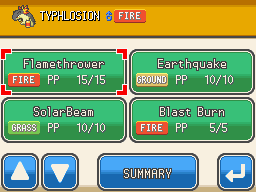
|

|
|---|---|---|
| Summary | Check Moves | Check Moves (description) |
Generation V

|
This section is incomplete. Please feel free to edit this section to add missing information and complete it. |
Pokémon Black and White
Pokémon Black 2
Pokémon White 2
Generation VI

|
This section is incomplete. Please feel free to edit this section to add missing information and complete it. |
Pokémon X and Y
Pokémon Omega Ruby and Alpha Sapphire
Generation VII

|
This section is incomplete. Please feel free to edit this section to add missing information and complete it. |
Pokémon Sun and Moon
Pokémon Ultra Sun and Ultra Moon
Pokémon Let's Go! Pikachu and Eevee
Generation VIII
Pokémon Sword and Shield

|
This section is incomplete. Please feel free to edit this section to add missing information and complete it. Reason: EV graph display after pressing X on the stats page (Screen 2) |

|
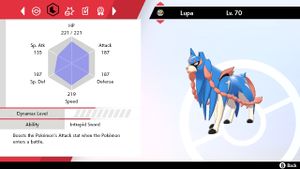
|
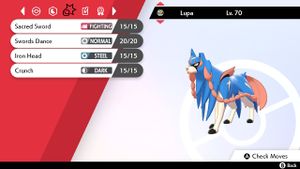
|
|---|---|---|
| Screen 1 | Screen 2 | Screen 3 |
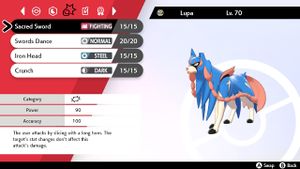
|
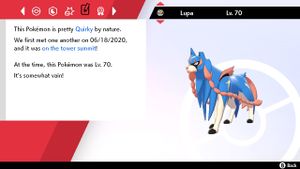
|

|
| Screen 3 (move description) |
Screen 4 | Screen 5 |
- On Screen 2, the stat graph (in dark blue) is scaled to the Pokémon's actual stats. This means that the graph will increase in size as the Pokémon levels up, and that a Pokémon with equal base stats (such as Mew), a neutral nature, and equal IVs and EVs will still display a bulge at HP due to the HP stat formula being different. This graph is capped at approximately 300 (any stat over 300 will reach the edge) and is also lower-bounded at approximately 10% (even Shedinja's HP will still take up about 10% of the graph).
- Pressing the X button on Screen 2 will change the stat graph to display EVs. The exact number of effort values is not revealed. This button functionality is not mentioned in the footer at the screen bottom. This view has two graphs overlaid:
- The dark yellow graph represents EVs. The EVs graph is also lower-bounded at approximately 10% (for stats with 0 EVs) and the edge of the graph represents exactly 252 EVs. Once a Pokémon is Fully Trained, the dark yellow color will change to light blue.
- The light yellow graph represents base stats, IVs and nature,[citation needed] and does not change size or shape as the Pokémon levels up. It does not appear to be scaled to the Pokémon's actual stats, as there is no HP bulge for Pokémon with equal base stats/IVs/EVs and neutral nature. The 10% lower-bound represents a hypothetical base stat of 0 with 0 IVs, while the edge of the graph represents a base stat of 255 with 31 IVs[citation needed] (for example, most Chansey will have their HP barely miss the edge of the graph). Due to the two different scales involved, there is nothing significant about any part of the EV graph exceeding the bounds of the light yellow graph.
- The above representation of base stats, IVs and nature does not take into account Shedinja's unique HP override. A Shedinja with a very high HP IV may have the HP part of its graph well over the 10% minimum and very close to some of its other low stats such as Special Attack and Special Defense. In contrast, a Chansey with a very low Attack/Defense IV may display closer to the 10% minimum than Shedinja's HP.
In battle
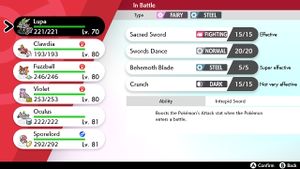
|
|---|
| Summary |
Pokémon Brilliant Diamond and Shining Pearl

|

|

|

|
|---|---|---|---|
| Screen 1 | Screen 2 | Screen 3 | Screen 4 |

|
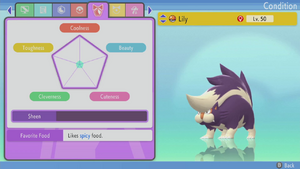
|

|
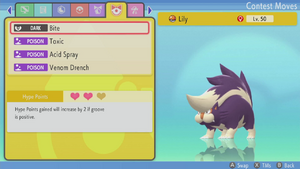
|
| Screen 4 (move description) |
Screen 5 | Screen 6 | Screen 6 (move description) |
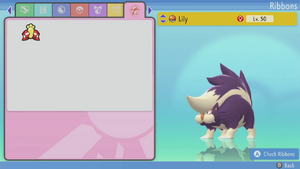
|

| ||
| Screen 7 | Screen 7 (ribbon description) |
In battle

|

|
|---|---|
| Summary | Summary (move description) |
Pokémon Legends: Arceus

|
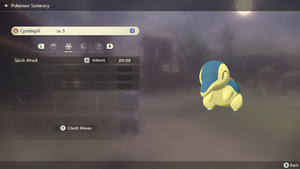
|

|
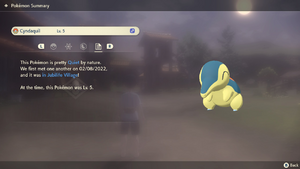
|
|---|---|---|---|
| Screen 1 | Screen 2 | Screen 3 | Screen 4 |
Trivia
- In game manuals, the word "summary" is usually written in lowercase (or all-caps "SUMMARY" like in the game interface). However, the manual of Pokémon Platinum inconsistently uses either "Summary" or "summary".
- In Generation I and II, the abbreviation ":L" is shown before the Pokémon's current level, and also in the text displaying how much experience is required to the next level. For instance, ":L25" means "level 25". However, level 100 is shown as just "100", without ":L".
In other languages
- Generations I and II
| ||||||||||||||||||||||||
- from Generation III to Ultra Sun and Ultra Moon
| ||||||||||||||||||||||||
- Let's Go! Pikachu and Eevee, Sword and Shield
| ||||||||||||||||||

|
This game mechanic article is part of Project Games, a Bulbapedia project that aims to write comprehensive articles on the Pokémon games. |